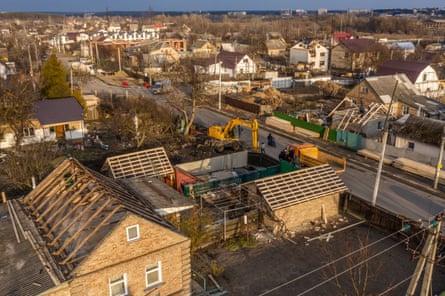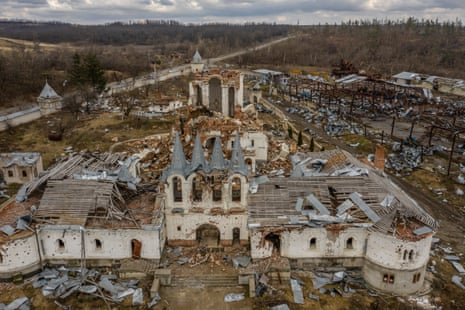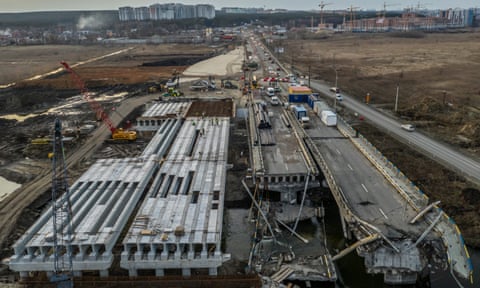Standing on the crumbling roof of a house, dozens of workers hammer in unison. Around them, cranes, bulldozers and trucks work frantically to repair roads and buildings destroyed by Russian artillery. It is hard to believe that this noisy construction site is in Yablonska Street, in the town of Bucha, in the north of Kyiv, at the precise crossroads where a year ago the bodies of dozens of civilians, brutally killed by Russian soldiers, were strewn over almost a mile, some with their hands bound behind their backs.
Ukraine has already repaired, and in many cases fully rebuilt, many of the sites destroyed by Moscow, including bridges, roads and government buildings. It is only the beginning of what Kyiv has described as the largest rebuilding effort since the second world war and perhaps the most expensive in history, with an estimated cost of half a trillion dollars. But managing this unprecedented influx of money in a country with a long history of corruption will bring challenges, experts say.
“Under the Marshall plan, the US programme that provided economic assistance to restore the infrastructure of postwar Europe, Washington contributed $13.3bn in aid to 16 countries,” says Donald Bowser, the founder of Support to Ukrainian Recovery Initiative, an NGO focused on recovery projects in formerly occupied areas of Ukraine. “That’s approximately $150bn [£121bn] in today’s dollars. Rebuilding Ukraine could cost the west four or five times as much. Nobody has ever invested all this money for the reconstruction of a single country.”

When early in July last year Ukraine’s president, Volodymyr Zelenskiy, said the reconstruction of war-torn Ukraine would begin before the end of hostilities with Russia, many western leaders were sceptical. The idea of starting to rebuild a country while its cities continued to be devastated by Russian bombs seemed foolish as well as dangerous. And yet, Zelenskiy has been as good as his word.
One of the most iconic images of the war dates back to early March 2022. The photo featured hundreds of civilians crowded together under the remains of a key bridge that connected Irpin to the city of Bucha, which at that moment held those people suspended between life and death: on one hand, the Russian artillery advancing from the north; on the other, the safety on the road to Kyiv. A year on, dozens of workers have nearly completed its restoration.

In the last year, Ukraine has cleared debris from 2,100km of roads, of which it has repaired 120km, rebuilt 41 of 330 destroyed bridges, created 80 temporary passages and renewed 900 railway points, such as train stations and train depots.
“When we’re talking about transportation, there are a few key tasks we’re trying to achieve,” says the deputy minister of infrastructure, Oleksandra Azarkhina. “First is to prevent a humanitarian crisis inside the country, and second to prevent a global food crisis. Restoring the principal transportation routes it is also crucial to continue to supply our frontlines. Are we aware that what we have rebuilt could be destroyed again? Yes, but it is a risk that we’re forced to take. And frankly speaking, rebuilding is also part of our resistance”
As of January, Kyiv School of Economics reported a total of 149,300 residential buildings damaged, 330 hospitals, 595 administrative buildings and more than 3,000 schools and university buildings.
The building work completed so far has been paid for out of Ukraine’s cash reserves, and from an initial $600m payout from the European Investment Bank, which approved a second package of €1.59bn (£1.4bn) in July 2022.
According to the latest evaluation, Ukraine’s reconstruction and recovery needs have reached $411bn, the World Bank said. However, the estimate is constantly growing due to the continuous bombing and because no reliable data is available in the occupied territories. Ukraine’s prime minister, Denys Shmyhal, has said the cost of rebuilding could reach $750bn.

“The overall damage is terrible and not everything which was destroyed will need to be rebuilt,” says Azarkhina. “The country changed, the population moved. We need to be wise in using this money. But let’s not forget that Ukraine didn’t destroy its infrastructure, Russia did; they are the bad guys and they need to pay for that.”
International media have been asking how realistic Russian reparation payments are. In February, Poland and the Baltic states urged the EU and western governments to use Russia’s €300bn (£266bn) of frozen central bank reserves to start rebuilding the country. But experts have argued that redeploying Russian assets would breach international law.
Azarkhina says Ukraine has frozen several hundred million euros of Russian assets in the country, citing how Kyiv’s justice minister is working to settle legal issues in order to use the money to rebuild private houses.
after newsletter promotion

An essential part of the reconstruction will also be paid for by private foreign investment. Many of the destroyed businesses will not be resurrected simply by repairing the buildings that housed them should Ukraine win the war, while thousands of Ukrainian soldiers returning to their cities from the frontlines will need work.
“We need to create employment,” says Sergiy Tsivkach, the CEO of UkraineInvest, Ukraine’s investment promotion office, “to transform the country from an exporter of raw materials into a prosperous European state with a developed industry.”
Tsivkach says he has already received numerous requests from foreign companies and dozens of projects are already under way, but some investors are still wary.
There is not only the issue of investing in a country still under bombardment. Another problem is the widespread corruption that has plagued Ukraine since independence. Transparency International ranked Ukraine as the second most corrupt country in Europe in 2021, behind only Russia.

“The international community should be very afraid of how corruption might compromise reconstruction, and it should begin immediately to take measures to combat it,” says Bowser, who has worked for 25 years on governance and anti-corruption programs for various donor organisations. “Corruption is still endemic there.”
With Ukraine taking its first steps to EU accession, the government is under pressure to show it has cleaned up its act. In the last few months, dozens of senior officials have been sacked and Zelenskiy has declared a zero-tolerance approach.
“Ukraine made significant steps recently,” says Tsivkach. “In the past, we had many scandals. We have seen them on TV, but we did not see proper enforcement following these scandals. What’s happening now is that we see a case of corruption and a quick reaction from thestate to press charges against those responsible.”
However, much remains to be done. “One of the lessons I have learned from being in Ukraine is that there is a new cadre of voices who are serving on the frontlines who won’t accept passively sitting by while the country is looted again,” says Bowser. “One million Ukrainian veterans returning from the war, with missing limbs, who bled for this country, are not going to accept things as they were before 2014.”
“These people,” Bowser adds, “they won’t be throwing corrupt officials into garbage cans like they did in the past, but hanging them from lamp-posts.”
